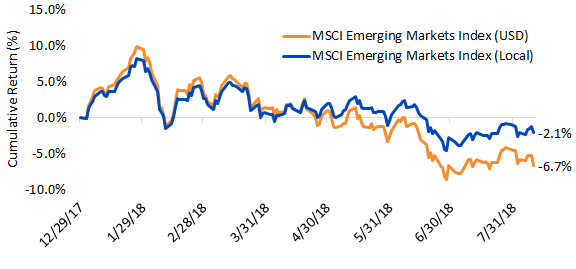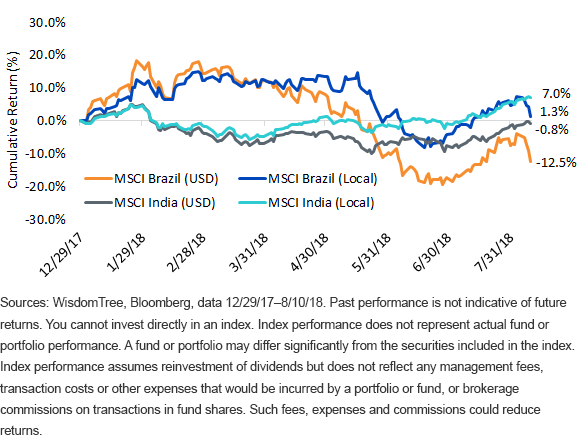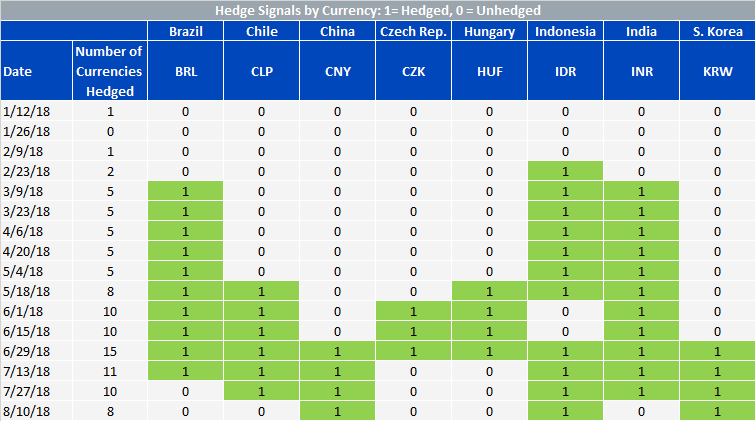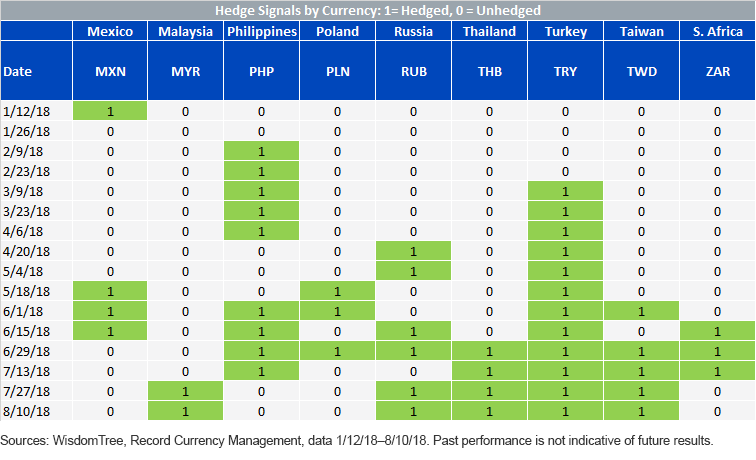Do You Have a Process for Managing Currency Risk?


As of August 10, the decline in emerging market equity indexes in 2018 has been driven more by currency movements than equity markets; the stocks in local currency terms were down 2.1%, while the broad MSCI Emerging Markets Index was down 6.7%.
There are a number of markets where the stocks are reaching new all-time highs, like India, whose market was up 7% in local terms—but when including the rupee decline, was down about 1% in U.S. dollar terms. Brazil is another market that was up 1.3% in local terms but down 12.5% when factoring in currency losses.
MSCI Emerging Markets YTD
(12/29/17—8/10/18)

MSCI Brazil and MSCI India YTD
(12/29/17—8/10/18)

WisdomTree has been advocating currency hedging in developed markets where one is paid the higher interest rate differentials, versus the countries in the eurozone or Japan, both places that currently have negative short-term interest rates. With interest rate differentials as high as 2% a year today, collecting the interest rate differentials by hedging these currencies makes removing uncertain currency moves a very useful and profitable proposition.
Due to their higher interest rates, emerging markets tend to have higher hedging costs. That higher cost is one reason WisdomTree historically avoided directly targeting broad emerging markets with currency-hedged options. But around three years ago, WisdomTree launched a suite of developed market currency strategies that employ a multi-factor model to vary the hedge ratio every month. Those hedge ratios in the developed world look at valuations (based on purchasing power parity levels), interest rate differentials (the “carry” factor, which is either a cost or how much one is paid to hedge) and, finally, momentum. Value and momentum are familiar factors for equity investors and carry helps manage the cost to hedge in the developed world.
As we explored applying these factors to emerging markets, it became evident that emerging market currencies would always have a higher hedging “cost” and therefore could not use a similar signal as the developed world. Similarly, the valuation levels always imply a discount and being undervalued in purchasing power parity (PPP) terms.
A signal that did work for emerging markets is momentum. Stated simply, once currencies start to trend downward, some of that momentum follows through and there can be gains (or protection from losses) from utilizing hedges.
There are many multi-factor equity processes in the ETF world today. But it is much rarer that you will find someone who has also thought carefully about currency exposures.
Our research for hedging emerging market currencies was being conducted in 2016–2017, and our model for hedging emerging markets was agreed upon in 2017.
Hedge Ratio Process
Three momentum factors aggregated into a high conviction overlay. When the short-term moving average of the currency’s spot price versus the U.S. dollar is weaker than the long-term moving average, the hedge ratio will be on for that signal:
- Short-term (5- and 30-day moving average)
- Medium-term (20- and 60-day moving average)
- Long-term (10- and 240-day moving average)
Binary Hedging: 100% hedged or unhedged for each currency when the short-term moving average crosses below the long-term moving average. When these moving average signals cross, it shows the currency is declining on multiple time periods and implies further losses ahead. When even the short-term signal reverses, the hedge ratio comes off.
Rebalance Frequency: Biweekly
One of the reasons we like the process of hedging completely when these momentum signals are all fired on is that it helps reduce the hedging cost. Based on our research, we believe over time these signals will likely be deployed about 20% of the time on average.
When we launched the WisdomTree Emerging Markets Multifactor Fund (EMMF) on August 10, approximately 70%1 of the currency exposure was hedged by this momentum model, reinforcing how this year’s volatility in emerging markets has really been currency volatility.
Below we show the momentum model by currency and when it was triggered on or off thus far in 2018 on each biweekly hedge reset date.


Do You Have a Robust Process for Managing Currency Exposures?
The standard narrative we hear from investors is that with currencies, it’s just “a wash” in the long run and that any gains one might get from hedging will be eaten up by the higher costs of hedging. Our research shows that applying this dynamic momentum model will help reduce the cost of hedging by typically being hedged 20% of the time on average—and that these hedges should help lower the volatility of emerging markets significantly.
If one of the reasons you allocate less to foreign markets is their high levels of volatility, EMMF incorporates a factor approach that targets lower volatility from the equity process and currency process and, I believe, would be a useful addition to your portfolio.
1Source: WisdomTree, as of 8/10/18.
Important Risks Related to this Article
Investments in emerging, offshore or frontier markets are generally less liquid and less efficient than investments in developed markets and are subject to additional risks, such as risks of adverse governmental regulation and intervention or political developments.
Investing involves risks, including possible loss of principal. Investments in non-U.S. securities involve political, regulatory and economic risks that may not be present in U.S. securities. For example, foreign securities may be subject to risk of loss due to foreign currency fluctuations, political or economic instability or geographic events that adversely impact issuers of foreign securities. Derivatives used by the Funds to offset exposure to foreign currencies may not perform as intended. There can be no assurance that the Funds’ hedging transactions will be effective. The value of an investment in the Funds could be significantly and negatively impacted if foreign currencies appreciate at the same time that the value of the Funds’ equity holdings falls. The Funds are actively managed using proprietary investment strategies and processes. There can be no guarantee that these strategies and processes will be successful or that the Fund will achieve its investment objective.

Jeremy Schwartz has served as our Global Chief Investment Officer since November 2021 and leads WisdomTree’s investment strategy team in the construction of WisdomTree’s equity Indexes, quantitative active strategies and multi-asset Model Portfolios. Jeremy joined WisdomTree in May 2005 as a Senior Analyst, adding Deputy Director of Research to his responsibilities in February 2007. He served as Director of Research from October 2008 to October 2018 and as Global Head of Research from November 2018 to November 2021. Before joining WisdomTree, he was a head research assistant for Professor Jeremy Siegel and, in 2022, became his co-author on the sixth edition of the book Stocks for the Long Run. Jeremy is also co-author of the Financial Analysts Journal paper “What Happened to the Original Stocks in the S&P 500?” He received his B.S. in economics from The Wharton School of the University of Pennsylvania and hosts the Wharton Business Radio program Behind the Markets on SiriusXM 132. Jeremy is a member of the CFA Society of Philadelphia.

